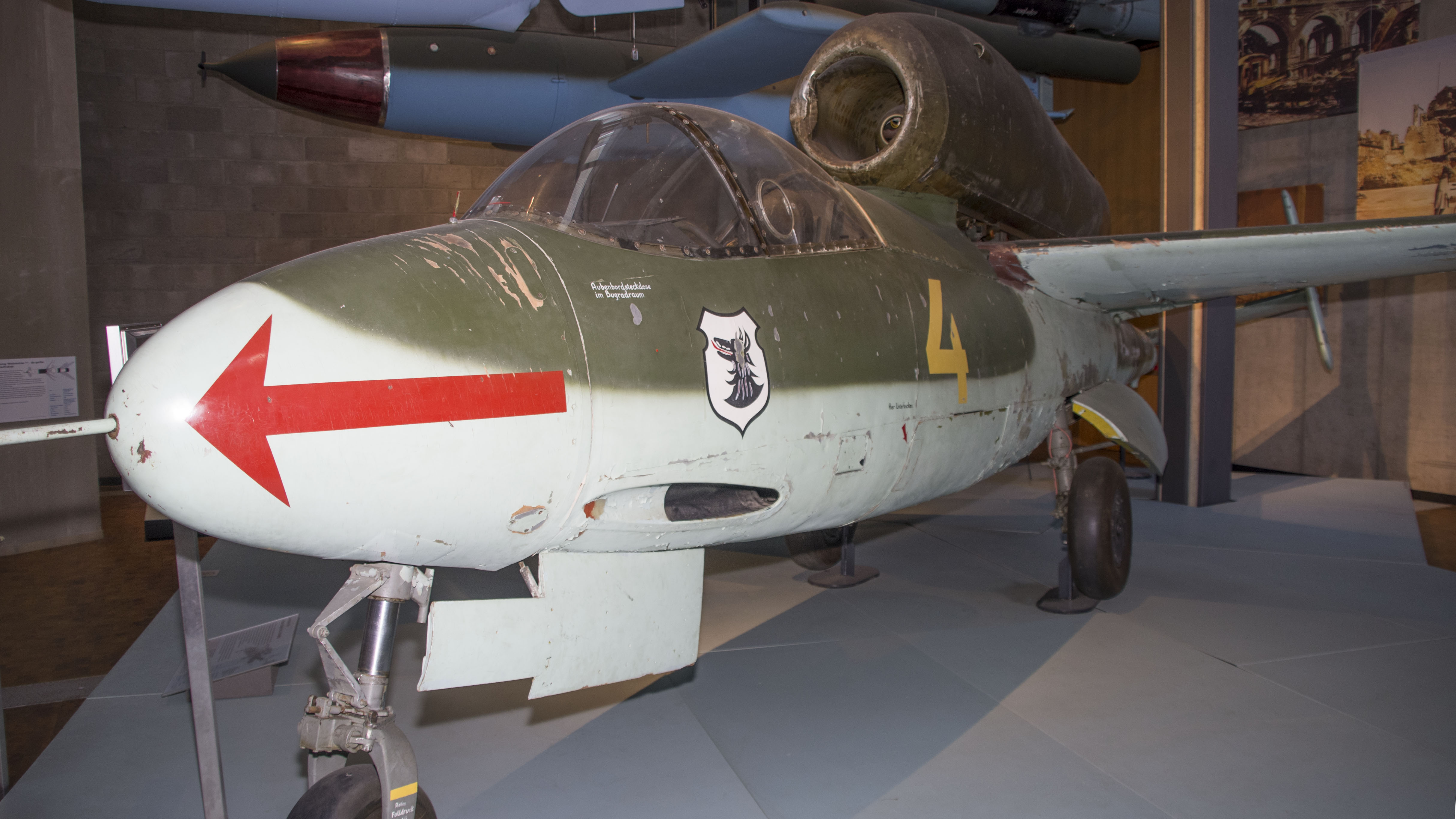
The Heinkel He 162 Volksjäger was a German single-engine, jet-powered fighter aircraft fielded by the Luftwaffe in World War II. The first prototype of the He-162 was rolled out at the beginning of December 1944. It made its initial flight on 6 December from the airfield at Schwechat near Vienna, with test pilot Gotthold Peter at the controls.
Developing nation: Germany.
Manufacturer/designer: Heinkel.
Production line: Schwechat, Austria, Heinkel plant in Marienhe, the Junkers plant at Bernberg, and in the infamously brutal SS underground slave-labor factory near Nordhausen in the Harz Mountains, known as Mittelwerk.
Type aircraft: Jet-Powered Fighter Aircraft.
First flight: 6 December 1944.
Produced: 1944 – 1945.
Built: 320
Sometimes referred to as Salamander, the Heinkel He 162 was a rushed attempt to provide a mass-produced fighter that would stem the Allied bombing offensive on Germany. It was submitted by Heinkel to meet an 8 September 1944 requirement for a simple, lightweight jet fighter. The project was completed in only 3 weeks. Hastily developed, the aircraft had still numerous problems at the time of it’s service introduction – structural, aerodynamic and technological. Only one version had been produced before the war ended, the He 162 A. It had two sub-variants, the A-1, armed with two 30mm MK108 cannon, and A-2, replacing these with high-velocity MG 151 20mm cannon.
He 162 planes were metal, which was scare and mostly wood. The location of the engine made it necessary for the first ejection seat to be build as any pilot bailing would have had his shute caught in the engine. The plane was designed to be used by Hitler youth as the fleet of pilots was no longer viable, having been mostly killed by this time. The engine on the top caused difficulties with unstable pitch. The plane was literally glued together in many places and with failure of that and others things it proved to be more difficult to fly and required an expert pilot.
After the war several examples found their way into allied hands, with the British, French, American and Soviet forces all test-flying the type. Heinkel He 162 Volksjäger still exist as static displays in museums around the world. None remain flying.
Variants
- He 162 A-0 — first ten pre-production aircraft.
- He 162 A-1 — 2 × 30 mm (1.18 in) MK 108 cannons with 50 rounds per gun.
- He 162 A-2 — 2 × 20 mm MG 151/20 cannons, 120 rpg.
- He 162E — He 162A fitted with the BMW 003R mixed power plant, a BMW 003A turbojet with an integrated BMW 718 liquid-fuel rocket engine — mounted just above the exhaust orifice of the turbojet — for boost power. At least one prototype was built and flight-tested for a short time.
- He 162S — two-seat training glider.
- Tachikawa Ki 162 — License-built version of He 162A in Japan, projected with Lorin ramjet and Argus pulsejet for first design.
General characteristics
- Crew: 1, pilot
- Length: 9.05 m (29 ft 8 in)
- Wingspan: 7.2 m (23 ft 7 in)
- Height: 2.6 m (8 ft 6 in)
- Wing area: 11.16 m² (156 ft²)
- Empty weight: 1,660 kg (3,660 lb)
- Max. takeoff weight: 2,800 kg (6,180 lb)
- Powerplant: 1 × BMW 003E-1 or E-2 (meant for ventral attachment) axial flow turbojet, 7.85 kN (1,760 lbf)
Performance
- Maximum speed: 790 km/h at normal thrust at sea level; 840 km/h at 6000 m; using short burst extra thrust 890 km/h at sea level and 905 km/h at 6000 m. (562 mph)
- Range: 975 km (606 mi)
- Service ceiling: 12,000 m (39,400 ft)
- Rate of climb: 1,405 m/min (4,615 ft/min)
Armament
- Guns: 2 × 20 mm MG 151 cannons with 120 rpg (He 162 A-2) OR 2 × 30 mm MK 108 cannons with 50 rpg (He 162 A-0, A-1)



All pictures courtesy of Zijde Aviation Photo and Publishing, Marcel van Leeuwen